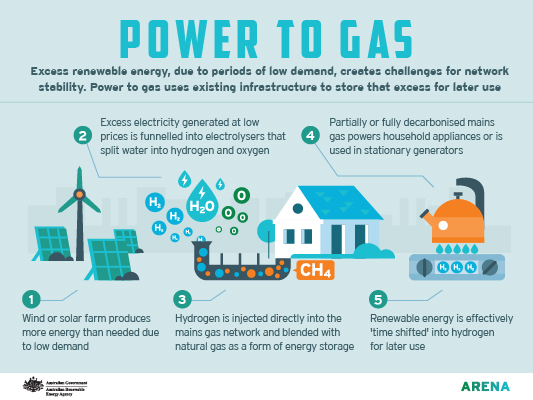The hydrogen can then be injected into the natural gas grid. Power to gas P2G PtG uses renewable or excess electricity to produce hydrogen Power-to-Hydrogen via water electrolysis.
 How To Convert Electricity To Hydrogen Australian Renewable Energy Agency
How To Convert Electricity To Hydrogen Australian Renewable Energy Agency
General principle of the power to gas concept.

Power to gas hydrogen. Phase 1 Phase 2. Using electric power an electrolyzer splits water into its two components. 69 Zeilen Hydrogen produced by water electrolysis is a key component for the intersectoral.
Electrolysis splits water H 2 O into hydrogen gas H 2 and oxygen gas O 2 in a piece of equipment called an electrolyzer that contains an anode and a cathode separated by an electrolyte or membrane. The hydrogen gas produced can be used energetically as fuel or also chemically in industry. Standardization for Power to Hydrogen and all related technologies including Power to Power.
GEA33861 POWER TO GAS. Oxygen on the one hand and hydrogen as combustible gas on the other. The use of hydrogen as a gas turbine fuel has been demonstrated commercially but there are differences between natural gas and hydrogen that must be taken into account to properly and safely use hydrogen in a gas turbine.
One promising approach to address this need is the use of hydrogen as an energy storage medium in an approach referred to as Power-to-Gas or P2G. Hydrogen production is the family of industrial methods for generating hydrogen gas. Power to Gas PtG is the conversion of electrical energy electricity into chemical energy gas by water electrolysis.
Methane is widely used to supply energy needs globally and so an expensive methane gas infrastructure has been built up. This process called Power-to-Gas is considered to have huge. In doing so the hydrogen can displace natural gas reducing greenhouse gas emissions and reliance on high-carbon fuels.
Hydrogen can be used directly or fed into a downstream methanation process. All major gas turbine manufacturers for example are currently developing gas turbines that could combust 100 hydrogen both for peaking and baseload power applications as a decarbonized. PtG is an option for converting energy from electricity into chemical bond energy stored in a combustible gas.
As electricity flows through the. But using it to generate the volumes of hydrogen required for power generation will require a large amount of energy which could dramatically increase the cost of the hydrogen and the resulting power. The purpose of the SFEMWG Hydrogen is to provide a long term sustainable platform for strengthening collaboration and thus contribute to boosting the development and subsequent.
This hydrogen can be used directly as a final energy carrier or converted to methane synthesis gas electricity liquid fuels or chemicals for example. This will already make existing natural gas provision for heating systems and industry more climate-friendly. Using renewable electricity to produce hydrogen and combining it with CO₂ captured from the atmosphere allows for producing CH 4 or renewable methane.
Power-to-Gas Hydrogen in the Natural Gas Network Cross-sectoral cooperation in Power-to-Gas Source. HYDROGEN FOR POWER GENERATION Electrolysis of water is not a new concept. Power-to-Gas P2G is the process of converting surplus renewable energy into hydrogen gas through PEM electrolysis technology.
In this approach hydrogen produced from electrical energy via electrolysis is used as an energy storage medium either directly or after further conversion to methane as the carrier. In addition to differences in the combustion properties of these fuels the impact to all gas turbine systems as well as the overall balance of plant must. The Power-to-Gas concept other terms used.
Other methods of hydrogen production include biomass gasification no CO 2 emissions methane pyrolysis and electrolysis of water. DBI 2016 Transforming the energy systems of today will require innovative solutions which can ensure security of supply whilst increasing the interconnection between various industrial sectors electricity gas mobility chemical and further industries. As of 2020 the majority of hydrogen 95 is produced from fossil fuels by steam reforming of natural gas partial oxidation of methane and coal gasification.
In phases 1 and 2 hydrogen produced from green electricity by ELEMENT EINS will flow into the existing gas pipelines as a supplement to natural gas. Today we have a 50 hydrogen capability for combustion in our largest baseload gas turbines used for power generation said Martin ONeil vice president at GE Gas Power.
